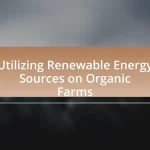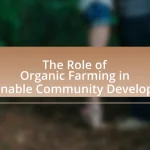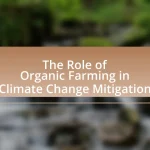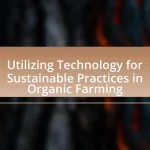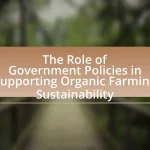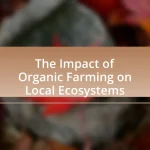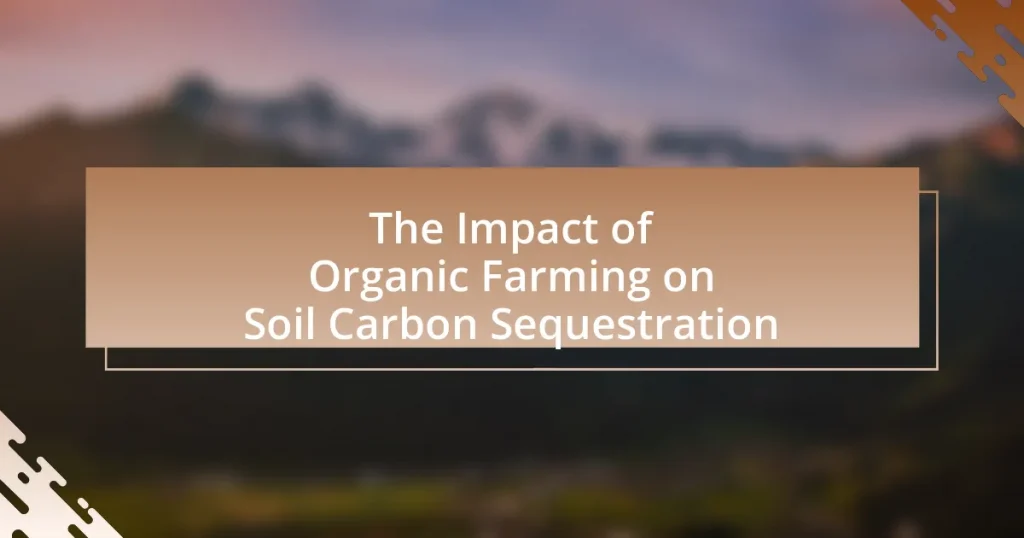The article examines the impact of organic farming on soil carbon sequestration, highlighting how practices such as crop rotations, cover cropping, and reduced tillage significantly enhance soil organic carbon levels. Research indicates that organic farming can sequester up to 30% more carbon compared to conventional methods, contributing to climate change mitigation and improved soil health. The article further explores the mechanisms of carbon storage in organic systems, the role of microbial activity, and the benefits of diverse cropping practices. Additionally, it addresses the challenges and limitations faced by organic farmers in maximizing carbon sequestration, as well as the potential for technological innovations and policy changes to support sustainable practices.
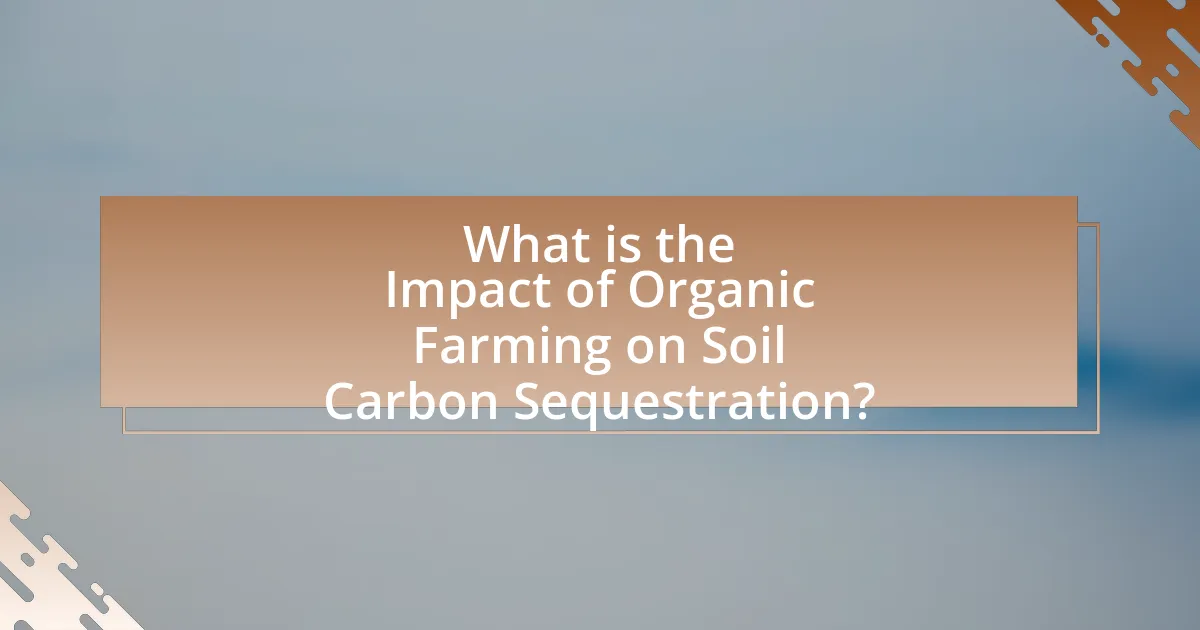
What is the Impact of Organic Farming on Soil Carbon Sequestration?
Organic farming significantly enhances soil carbon sequestration by promoting practices that increase organic matter in the soil. This method utilizes crop rotations, cover cropping, and reduced tillage, which contribute to higher soil organic carbon levels. Research indicates that organic farming systems can sequester up to 30% more carbon compared to conventional farming methods, as shown in a meta-analysis published in “Nature” by Gattinger et al. (2012). This increase in soil carbon not only mitigates climate change by reducing atmospheric CO2 levels but also improves soil health and fertility, creating a sustainable agricultural ecosystem.
How does organic farming contribute to soil carbon sequestration?
Organic farming contributes to soil carbon sequestration by enhancing soil organic matter through practices such as crop rotation, cover cropping, and reduced tillage. These methods increase the amount of carbon stored in the soil by promoting the growth of soil microorganisms and improving soil structure, which facilitates carbon retention. Research indicates that organic farming can sequester up to 1.5 to 2.5 times more carbon in the soil compared to conventional farming methods, as shown in studies conducted by the Rodale Institute. This increase in soil carbon not only mitigates climate change but also improves soil health and fertility.
What practices in organic farming enhance soil carbon storage?
Practices in organic farming that enhance soil carbon storage include cover cropping, reduced tillage, and the application of organic amendments such as compost. Cover cropping increases organic matter input and promotes soil microbial activity, which contributes to carbon sequestration. Reduced tillage minimizes soil disturbance, preserving soil structure and preventing carbon loss. The application of organic amendments enriches the soil with carbon-rich materials, further enhancing its capacity to store carbon. Research indicates that these practices can significantly increase soil organic carbon levels, with studies showing increases of up to 30% in carbon stocks over time when implemented effectively.
How does soil health influence carbon sequestration in organic systems?
Soil health significantly influences carbon sequestration in organic systems by enhancing the soil’s ability to store carbon through improved microbial activity, organic matter content, and soil structure. Healthy soils, characterized by high levels of organic matter and diverse microbial communities, promote the formation of stable soil aggregates that protect carbon from decomposition. Research indicates that organic farming practices, such as cover cropping and reduced tillage, can increase soil organic carbon levels by 20-30% compared to conventional farming methods. This increase in carbon storage is crucial for mitigating climate change, as it reduces atmospheric CO2 levels.
Why is soil carbon sequestration important for the environment?
Soil carbon sequestration is important for the environment because it helps mitigate climate change by reducing the concentration of carbon dioxide in the atmosphere. This process involves the capture and storage of atmospheric carbon in soil organic matter, which can enhance soil fertility and improve water retention. Research indicates that healthy soils can sequester significant amounts of carbon; for instance, a study published in “Nature” by Paustian et al. (2016) estimates that soil carbon sequestration could offset up to 1.8 billion metric tons of CO2 annually in the United States alone. Thus, effective soil management practices, particularly in organic farming, can play a crucial role in enhancing carbon storage and promoting environmental sustainability.
What role does soil carbon play in climate change mitigation?
Soil carbon plays a crucial role in climate change mitigation by sequestering carbon dioxide from the atmosphere, thus reducing greenhouse gas concentrations. This process occurs through the accumulation of organic matter in soil, which enhances soil structure, fertility, and water retention. Research indicates that healthy soils can store significant amounts of carbon; for instance, a study published in “Nature” by Lal et al. (2018) estimates that improving soil management practices could sequester up to 1.5 billion tons of carbon annually. Therefore, increasing soil carbon through practices such as organic farming not only contributes to climate change mitigation but also promotes sustainable agricultural systems.
How does increased soil carbon benefit agricultural productivity?
Increased soil carbon enhances agricultural productivity by improving soil structure, water retention, and nutrient availability. Higher soil carbon levels lead to better aggregation of soil particles, which enhances aeration and root penetration, ultimately supporting healthier plant growth. Additionally, studies show that soils rich in organic carbon can retain up to 20% more water, reducing irrigation needs and increasing resilience to drought conditions. Furthermore, increased soil carbon boosts microbial activity, which aids in the breakdown of organic matter and the release of essential nutrients, thereby promoting higher crop yields. Research indicates that farms implementing organic practices, which typically increase soil carbon, can experience yield increases of 10-20% compared to conventional farming methods.
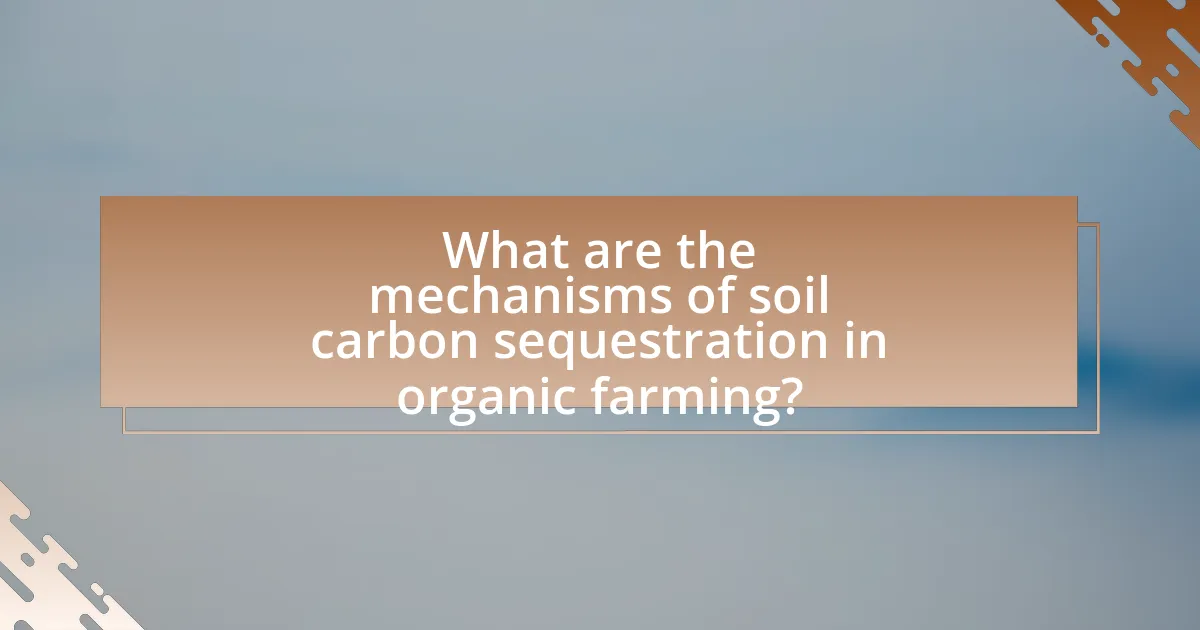
What are the mechanisms of soil carbon sequestration in organic farming?
Soil carbon sequestration in organic farming occurs primarily through enhanced soil organic matter accumulation, reduced soil disturbance, and increased biodiversity. Organic farming practices, such as cover cropping, crop rotation, and the application of organic amendments like compost, contribute to the formation of stable soil organic carbon. These practices improve soil structure and promote microbial activity, which further aids in carbon storage. Research indicates that organic farming can sequester up to 30% more carbon in the soil compared to conventional farming methods, as shown in studies by the Rodale Institute, which highlight the long-term benefits of organic practices on soil health and carbon dynamics.
How do organic amendments affect soil carbon levels?
Organic amendments significantly increase soil carbon levels by enhancing the organic matter content in the soil. When materials such as compost, manure, or cover crops are added to the soil, they decompose and contribute to the formation of stable organic carbon compounds. Research indicates that the application of organic amendments can lead to an increase in soil organic carbon by 10-30% over several years, depending on the type and amount of amendment used. For instance, a study published in “Soil Biology and Biochemistry” by Lehmann and Kleber (2015) demonstrated that organic amendments improve soil structure and microbial activity, which in turn promotes carbon sequestration.
What types of organic materials are most effective for carbon sequestration?
The most effective types of organic materials for carbon sequestration include compost, biochar, and cover crops. Compost enriches soil with organic matter, enhancing its ability to store carbon; studies show that compost application can increase soil organic carbon levels by 10-30%. Biochar, a stable form of carbon produced from biomass, can sequester carbon for hundreds to thousands of years, with research indicating that it can increase soil carbon content by up to 50%. Cover crops, such as legumes and grasses, improve soil structure and increase organic matter, contributing to carbon sequestration by capturing atmospheric CO2 during their growth cycle.
How does microbial activity influence carbon storage in organic soils?
Microbial activity significantly enhances carbon storage in organic soils by facilitating the decomposition of organic matter and the formation of stable soil organic carbon. Microorganisms break down complex organic materials, releasing nutrients and converting carbon into forms that can be stabilized in the soil matrix. Research indicates that microbial biomass contributes to the formation of aggregates, which protect carbon from further decomposition, thus increasing its longevity in the soil. For instance, studies have shown that soils with higher microbial diversity and activity can store up to 30% more carbon compared to less active soils, demonstrating the critical role of microbial processes in carbon sequestration.
What is the relationship between crop diversity and soil carbon sequestration?
Crop diversity enhances soil carbon sequestration by promoting a variety of root structures and microbial communities that improve soil health. Research indicates that diverse cropping systems can increase organic matter inputs and reduce soil erosion, leading to higher carbon storage in the soil. For instance, a study published in “Agriculture, Ecosystems & Environment” by Zhang et al. (2020) found that fields with higher crop diversity sequestered up to 30% more carbon compared to monoculture systems. This relationship underscores the importance of crop diversity in sustainable agricultural practices aimed at mitigating climate change through enhanced soil carbon storage.
How does crop rotation impact soil carbon dynamics?
Crop rotation enhances soil carbon dynamics by increasing organic matter input and improving soil structure. Different crops contribute varying root systems and residues, which promote microbial activity and carbon sequestration. Research indicates that diverse crop rotations can lead to a 10-20% increase in soil organic carbon compared to monoculture systems, as demonstrated in studies by the USDA Agricultural Research Service. This practice not only boosts carbon storage but also enhances soil fertility and resilience against erosion.
What benefits does polyculture offer for carbon sequestration?
Polyculture enhances carbon sequestration by promoting biodiversity, which improves soil health and increases organic matter. Diverse plant species in polyculture systems contribute to a more complex root structure, allowing for greater carbon storage in the soil. Research indicates that polyculture can increase soil organic carbon levels by up to 30% compared to monoculture systems, as demonstrated in studies conducted by the Rodale Institute. Additionally, the varied root systems and plant residues from multiple species enhance microbial activity, further facilitating carbon capture and retention in the soil.
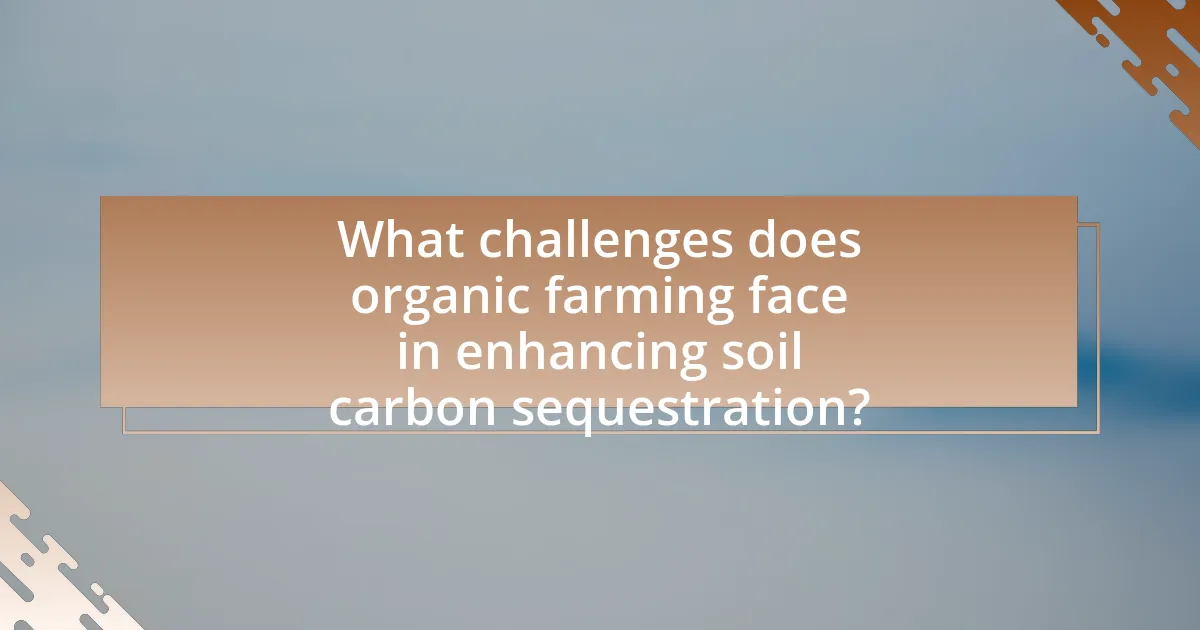
What challenges does organic farming face in enhancing soil carbon sequestration?
Organic farming faces several challenges in enhancing soil carbon sequestration, primarily due to limited access to resources and practices that optimize carbon storage. One significant challenge is the reliance on organic inputs, which can be less effective in increasing soil organic matter compared to synthetic fertilizers. Research indicates that organic farming systems often have lower yields, which can limit the amount of biomass returned to the soil, thereby reducing potential carbon sequestration. Additionally, organic farmers may struggle with soil erosion and nutrient depletion, which can further hinder the accumulation of soil carbon. A study published in “Agriculture, Ecosystems & Environment” by Gattinger et al. (2012) found that while organic farming can enhance soil carbon levels, the variability in practices and environmental conditions can lead to inconsistent results in carbon sequestration rates.
What are the limitations of current organic farming practices?
Current organic farming practices face several limitations, including lower yields compared to conventional farming, reliance on crop rotation which can limit the types of crops grown, and challenges in pest and weed management. Research indicates that organic farms typically produce 20-25% less than conventional farms due to restrictions on synthetic fertilizers and pesticides, which can hinder productivity (Reganold & Wachter, 2016, Nature Plants). Additionally, organic farming often requires more land to achieve the same output, which can lead to land-use conflicts. Furthermore, the certification process for organic farming can be complex and costly, limiting access for small-scale farmers. These factors collectively impact the scalability and economic viability of organic farming practices.
How do economic factors affect the adoption of carbon-sequestering practices?
Economic factors significantly influence the adoption of carbon-sequestering practices by determining the financial viability and incentives for farmers. For instance, the cost of implementing such practices, including investments in organic farming techniques, can deter adoption if farmers perceive low immediate financial returns. Research indicates that subsidies and financial incentives can enhance adoption rates; a study by the Environmental Protection Agency found that farmers receiving financial support for sustainable practices were 30% more likely to implement carbon-sequestering methods. Additionally, market demand for carbon credits can create economic opportunities, encouraging farmers to adopt practices that enhance soil carbon sequestration. Thus, economic factors, including costs, incentives, and market demand, play a crucial role in shaping the adoption of these environmentally beneficial practices.
What barriers exist in measuring soil carbon sequestration accurately?
Barriers in measuring soil carbon sequestration accurately include variability in soil types, lack of standardized measurement techniques, and difficulties in capturing temporal changes. Soil types exhibit different carbon storage capacities, which complicates comparisons across regions. The absence of universally accepted protocols for sampling and analysis leads to inconsistencies in data collection. Additionally, carbon sequestration is a dynamic process influenced by environmental factors, making it challenging to obtain precise measurements over time. These factors collectively hinder the accuracy of soil carbon sequestration assessments.
How can organic farmers improve soil carbon sequestration?
Organic farmers can improve soil carbon sequestration by implementing practices such as cover cropping, reduced tillage, and organic amendments. Cover cropping enhances soil structure and increases organic matter, which contributes to carbon storage. Reduced tillage minimizes soil disturbance, preserving existing carbon stocks and promoting microbial activity that aids in carbon retention. Additionally, the application of organic amendments, such as compost and manure, enriches soil with nutrients and organic matter, further enhancing its capacity to sequester carbon. Research indicates that these practices can significantly increase soil organic carbon levels, with studies showing that cover cropping can increase soil carbon by up to 1.5 tons per hectare annually.
What best practices should organic farmers adopt for maximizing carbon storage?
Organic farmers should adopt practices such as cover cropping, reduced tillage, and compost application to maximize carbon storage in soil. Cover cropping enhances soil organic matter and promotes microbial activity, which increases carbon sequestration. Reduced tillage minimizes soil disturbance, preserving soil structure and preventing carbon loss. Compost application enriches soil with organic matter, further enhancing its carbon storage capacity. Research indicates that these practices can significantly increase soil carbon levels, with studies showing that cover crops can increase soil organic carbon by up to 1.5 tons per hectare annually.
How can technology aid in enhancing soil carbon sequestration in organic farming?
Technology can enhance soil carbon sequestration in organic farming through precision agriculture, which utilizes data analytics, remote sensing, and soil monitoring tools. These technologies enable farmers to optimize inputs and practices, such as cover cropping and reduced tillage, which are known to increase organic matter in the soil. For instance, studies have shown that precision agriculture can lead to a 20% increase in soil carbon levels by improving nutrient management and reducing soil disturbance. Additionally, the use of bioinformatics and modeling software allows for better prediction of carbon sequestration potential, enabling farmers to implement more effective carbon farming practices.
What future trends are emerging in organic farming and soil carbon sequestration?
Future trends in organic farming and soil carbon sequestration include the increased adoption of regenerative agricultural practices, enhanced soil management techniques, and the integration of technology for monitoring soil health. Regenerative practices, such as cover cropping and reduced tillage, are gaining traction as they improve soil structure and increase organic matter, leading to higher carbon sequestration rates. Research indicates that these methods can sequester up to 1.1 billion tons of carbon dioxide annually in the U.S. alone. Additionally, advancements in precision agriculture technology, including soil sensors and data analytics, enable farmers to optimize their practices for better carbon capture and soil health. These trends reflect a growing recognition of the role of organic farming in mitigating climate change through effective soil carbon management.
How might policy changes influence organic farming practices related to carbon sequestration?
Policy changes can significantly enhance organic farming practices related to carbon sequestration by providing financial incentives and regulatory frameworks that promote sustainable land management. For instance, government subsidies for organic practices that improve soil health can encourage farmers to adopt techniques such as cover cropping and reduced tillage, which are known to increase soil organic carbon levels. Research indicates that organic farming systems can sequester up to 30% more carbon in the soil compared to conventional methods, as shown in studies by the Rodale Institute. Additionally, policies that support carbon credit markets can create economic opportunities for organic farmers who implement practices that enhance carbon sequestration, thereby aligning agricultural practices with climate goals.
What innovations are being developed to support soil carbon sequestration in organic systems?
Innovations being developed to support soil carbon sequestration in organic systems include the use of cover cropping, agroforestry, and biochar application. Cover cropping enhances soil organic matter and improves soil structure, which facilitates carbon storage. Agroforestry integrates trees into agricultural landscapes, increasing carbon capture through biomass accumulation. Biochar, a stable form of carbon produced from organic materials, can be added to soils to enhance carbon retention and improve soil fertility. Research indicates that these practices can significantly increase soil carbon stocks, with studies showing that cover crops can increase soil organic carbon by up to 1.5 tons per hectare annually.
